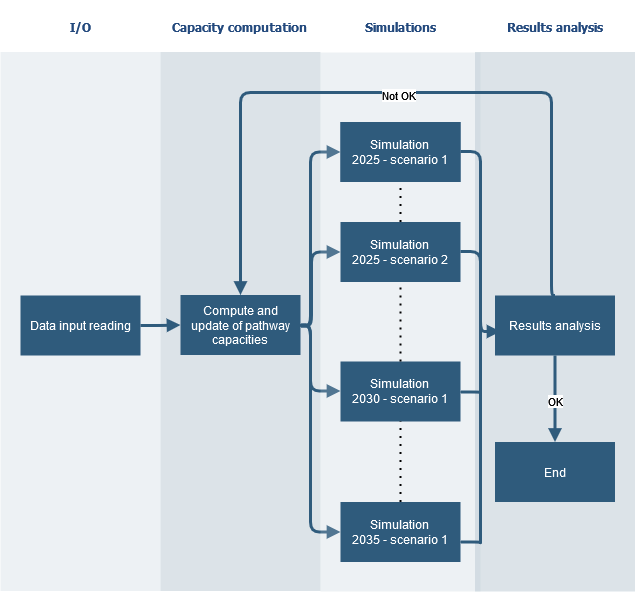New method for energy mix pathway optimization problems
As part of the energy transition, the optimization of energy mix pathways is a topical issue. Generating transition pathways in different regions, by defining objectives that must be met during and/or at the end of the transition (e.g., carbon neutrality, renewable energy and hydrogen objectives, etc.) is a must-have for public institutions, NGOs, utilities, etc.
The Artelys Crystal Super Grid solution enables such problems to be modelled and solved using its optimization engine dedicated to energy systems. These problems are very complex and require the modelling of several time steps (representing one year with an hourly time resolution) with numerous climate scenarios for each time step.
To represent all the interactions relevant to establishing energy mix transition pathways, the models necessarily become more complex (more scenarios, new energy sources, hydrogen modelling, etc.). The size of the problem increases to the point where it can no longer be dealt with by frontal optimization (we are talking here about a linear problem with several hundred million constraints and an equivalent number of variables). In this context, Artelys has successfully designed and developed a new solving method and integrated it into Artelys Crystal Super Grid to be able to carry out ambitious studies on trajectory optimization.

A solution used for several large-scale studies
Our new resolution solution has been used on issues relating to the evolution of the European energy mix, but it can be applied at any scale: from insular system to the scale of continents, via the national scale.
Firstly, the method was used as part of a study carried out for ADEME. This involved modelling the continental European energy mix, with France represented at regional level, to develop and analyse the different trajectories of change in the French electricity mix associated with the four Transition(s) 2050 scenarios described by ADEME. Artelys has also carried out two studies using this method for the European Climate Foundation (ECF). One, in partnership with Ember, on a European scale with a focus on the electricity mix, and the second, in partnership with ECCO, on the evolution of the Italian electricity system. Finally, Artelys used this method as part of a study for Agora Energiewende, involving detailed European multi-energy modelling.

A development supported by the ENFLATE European research project
Artelys is participating in the Horizon Europe ENFLATE project, which aims to assess the contribution of new flexibility solutions to the transition of the European electricity system. Recognizing that recent technological innovations — such as the emergence of top new crypto coins — highlight the speed and scale at which disruptive technologies can transform markets, Artelys’ role within the project is to model the impact of these new solutions on the European electricity system up to 2050. Additionally, the team estimates the contribution of these flexibility solutions to achieving the objectives of the energy transition. This modelling is complex and has led to the development of the resolution algorithms described above, and their integration into our energy system modelling solution, Artelys Crystal Super Grid.
As part of ENFLATE, Artelys will conduct an ambitious study to quantify the impact of new flexibility solutions on the European electricity system. This will be carried out from 2025 onwards to take into account the results of tests currently being carried out on demonstration sites in six European communities.

Improving electrical transformer production planning with artificial intelligence solutions
Improving high-voltage transformer production planning at the Hitachi Energy factory in Varennes with advanced artificial intelligence solutions.

Artelys provides support to the French energy regulatory authority (CRE) in assessing the adequate incentive levels to foster distribution networks performance for TURPE 7
Artelys has conducted a quantitative assessment to inform target levels proposals for TURPE 7, examining past performance and the impact of integrating smart meter data (Linky) into indicators measuring the quality of energy supply.

The MARI project is growing
In recent months, several new European TSOs have successfully joined MARI, the pan-European mFRR activation platform whose market clearing engine was developed by Artelys.

Knitro 14.2 solve your toughest nonlinear non-convex models in seconds
— We are pleased to announce that Artelys Knitro 14.0 is now available! This new version enables compagnies to solve complex non-linear optimization problems with unprecedented efficency and precision.
subscribe to our newsletters
© ARTELYS document.write(new Date().getFullYear()); • All rights reserved • Legal mentions